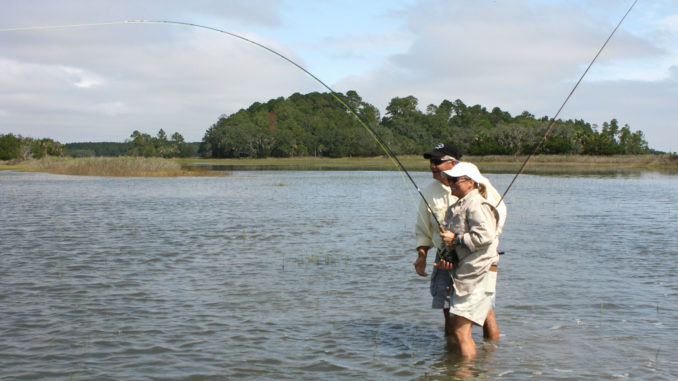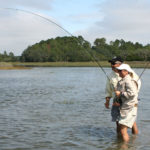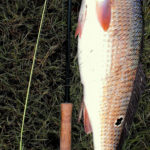
Take your saltwater fishing to a new level
For years, saltwater fly-fishing was thought of as something different from “regular” fishing; viewed as a fanciful way of angling by some and elitist by others. In recent years, however, many anglers have come to know saltwater fly-fishing for what it is; a way for them to catch more fish.
“Fly-fishing opens the door to a new level of satisfaction,” said Capt. Tuck Scott of Bay Street Outfitters in Beaufort. “There are many advantages in saltwater for the fly-caster over the spin-caster.”
Landing softly in and moving naturally through the water, flies are stealthy offerings. In situations where fish are easily spooked, wary or just tight-lipped, flies really shine when compared to artificial and sometimes even natural offerings.
“Often, redfish hunt in extremely shallow water and a fly lands softly, generally looks more realistic than conventional lures, and spooks far less fish,” said Scott Davis of Lowcountry Fly Shop in Charleston.
Fish are moody creatures; extreme temperatures, changes in weather and a host of other factors can turn the bite off like a light switch. When fishing become difficult, it is generally agreed that scaling back on the size of baits and slowing down is a good option. Flies may be the ultimate finesse lures because of the way they behave in the water.
“Flies tend to breathe more due to natural materials (fur and feathers) and can be fished slow or at rest and still have a pulsating action,” Davis said.
Many saltwater species of fish are taken by fly in South Carolina waters. Flounder, trout, mackerel and even cobia are targeted by fly fishermen, but by far the most sough-after gamefish are reds. In recent years, fly-fishing for redfish has really taken off from North Carolina all the way to Texas. An addictive experience, sight-fishing for reds with a long rod in shallow water is nothing like fishing as usual.
“The allure of fly-fishing to me is the fact that more stalking and hunting are involved,” Davis said. “It’s generally all sight-fishing to tailing or cruising fish; it’s very visual.”
Fly-fishing terminology is a language unto itself and a roadblock for many would-be fly fisherman. Fortunately, many outfitters and fly shops are eager to explain the lingo and guide them to the best set-up for the type of fishing they plan to do.
Davis said that most inshore fishing situations can be handled with one fly rod.
“A 9-foot, 8-weight fly rod for inshore saltwater is perfect because it can handle flies that tend to be heavier, and (it) has the backbone to turn a big fish’s head,” he said.
Different rods have different characteristics, even in the same line weight. One rod may have a slow action and flex the full length of the rod, while another may be fast and stiff except for the tip section. Everyone has a personal casting style, so the right combination of flex and action will vary from angler to angler.
Generally, fly rods and reels cost a little more than conventional spinning or casting outfits, so investing in the right rod is important. Scott recommends taking fly rods for a test drive on land before making a decision.
“A casting lesson before choosing a rod will help a great deal, because then you have a skill set to go to your fly shop with and actually cast a few rods so you can make an educated purchase,” he said. “I firmly believe that you should cast a rod before you purchase it.”
The most-difficult part of learning to fly-fish is learning to fly-cast properly. When fly-fishing, the angler casts using the weight of the line and not the weight of the lure. A quick cast often results in a very short cast and tangled line. A proper cast will allow the line to fully extend and load the rod before changing directions; the forward cast and the back cast should look the same.
“(Fly-casters) must remember they are not casting a fly or a lure, they are casting a fly line, (and) that the fly follows,” he said.
“Try this; lay out 40 feet of fly line behind you in a straight line and shoot it forward in one motion. It should lay out 40 feet in front of you. Do the same with 40 feet of line in a loose coil behind you and you should immediately see the importance of a straightened-out line.”
Stripped to its basic components, fly-fishing looses much of its mystery. By adding a fly rod to their bag of tricks, saltwater anglers can make their time on the water more productive. They can catch more fish, but there is more to fly-fishing than just catching fish. It is not something that is easy or learned overnight and in the early stages, it can be frustrating. But time invested is time well spent and allows anglers to gain a deeper appreciation of their quarry.
Davis compares fly-fishing to playing a violin.
“It can be easy to learn but can take a lifetime to master,” he said.
Scott sums it up this way: “I haven’t talked to anyone who has mastered fly-fishing.





Be the first to comment